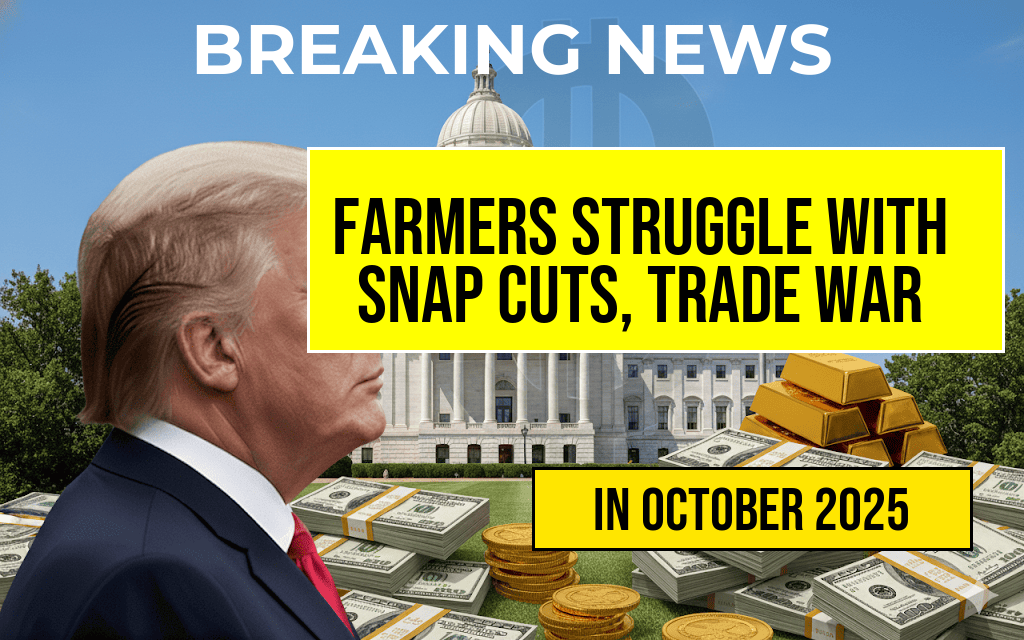Farmers across the United States are grappling with significant financial challenges, driven by recent cuts to the Supplemental Nutrition Assistance Program (SNAP) and the ongoing trade war. These factors have led to a sharp decline in income for many agricultural producers, threatening the livelihoods of countless families in rural America. With the U.S. Department of Agriculture (USDA) projecting a decrease in farm income for the year, the combination of reduced consumer spending power and market instability is forcing farmers to rethink their strategies and seek alternatives to stay afloat.
Impact of SNAP Cuts on Farmers
The recent cuts to SNAP have had a direct effect on agricultural sales, particularly for farmers who grow staple crops. According to the USDA Food and Nutrition Service, SNAP provides critical support to low-income households, and any reductions in this program can ripple through the entire food supply chain. Farmers who rely on a steady demand for their products are now witnessing a decline in sales as consumers tighten their budgets.
Financial Losses in the Agricultural Sector
A report by the USDA Economic Research Service indicates that farm income is expected to fall by 10% this year, translating to a loss of thousands of dollars for many producers. The effects are particularly pronounced in states heavily reliant on crops such as corn, soybeans, and dairy.
- Corn Farmers: Expected income drops of up to $20,000 per farm.
- Soybean Producers: Facing losses due to decreased export opportunities.
- Dairy Farmers: Struggling with low milk prices exacerbated by reduced consumer spending.
Trade War Complications
The ongoing trade war, particularly with China, has compounded the financial distress faced by American farmers. Tariffs imposed on agricultural exports have made it increasingly difficult for farmers to sell their products internationally, leading to oversupply in domestic markets and plummeting prices. The impact of these tariffs is profound, with many farmers reporting that they are unable to cover their production costs.
Resilience and Adaptation Strategies
In response to these challenges, farmers are exploring various strategies to remain viable. Some are diversifying their crops, while others are investing in direct-to-consumer sales through farmers’ markets and online platforms. Community-supported agriculture (CSA) programs are also gaining popularity as consumers seek to support local farmers.
- Crop Diversification: Planting a mix of crops to mitigate risks associated with market fluctuations.
- Direct Sales: Engaging consumers through local markets and online sales.
- Community Support: Building relationships with local communities to foster loyalty and encourage sustainable practices.
Government Assistance and Future Outlook
In light of the financial pressures facing farmers, some lawmakers are advocating for increased government support, including enhanced subsidies and expanded access to low-interest loans. However, the debate over agricultural policy remains contentious, with differing opinions on the best approach to support the struggling sector.
| Crop Type | Projected Income Change (%) | Average Loss per Farm ($) |
|---|---|---|
| Corn | -15% | 20,000 |
| Soybeans | -12% | 15,000 |
| Dairy | -10% | 18,000 |
The future for many American farmers remains uncertain. As they navigate the challenges posed by SNAP cuts and the trade war, the resilience and adaptability of the agricultural community will be crucial in determining their long-term viability. Farmers continue to seek solutions that not only support their operations but also contribute to the overall stability of the food supply chain in the United States.
Frequently Asked Questions
What are the main reasons for farmers facing financial strain?
Farmers are experiencing financial strain primarily due to SNAP cuts and the ongoing trade war. These factors have led to a significant decrease in income, affecting their overall financial stability.
How do SNAP cuts impact farmers’ income?
SNAP cuts reduce the purchasing power of low-income families, leading to decreased demand for agricultural products. This decline in demand results in lower sales and income for farmers.
What effects does the trade war have on the agriculture industry?
The trade war has resulted in tariffs and trade barriers that limit farmers’ access to international markets. This has caused a surplus of products domestically, pushing prices down and further straining farmers’ finances.
Are there any government measures being taken to support struggling farmers?
Yes, there have been discussions about potential government assistance programs to help farmers cope with financial difficulties caused by SNAP cuts and the trade war, but specific measures and their implementation can vary.
What can farmers do to mitigate their financial challenges?
Farmers can explore diversifying their crops, seeking alternative markets, and applying for financial aid programs to help mitigate the impact of reduced income from SNAP cuts and the trade war.













